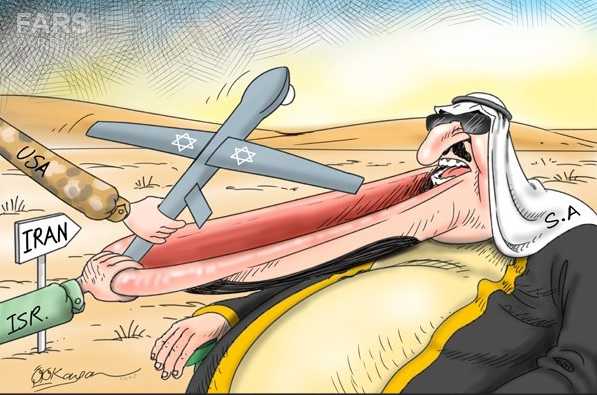http://jcpa.org/irans-threats-must-be-taken-seriously/
Iran’s Islamic Revolutionary Guards Corps (IRGC) announced on August 24 that it had shot down an Israeli reconnaissance unmanned aerial vehicle (UAV) over its uranium enrichment facilities in Natanz (Esfahan Province). The Guards Corps widely displayed the wreckage in its media outlets.
Brigadier General Amir Ali Hajizade, IRGC’s missiles and aerospace force commander, claimed that “the Zionist regime’s (Israel) Hermes series spy stealth UAV was shot down by IRGC’s air defense forces and that parts of the “Israeli drone” were “intact and were being analyzed by his office.” He added that the origin of the UAV flight was not Israel but one of the regional countries.
[Around the world, drone experts questioned if the wreckage was of Israeli origins or if it was a spy drone at all.]

Hadi Mohammadi, an Iranian expert on strategic affairs, charged that the UAV was launched from a U.S. warship in the Red Sea using an Arab state to enter Iran’s air space.1
Hajizade added that following the interception of the Israeli UAV and the “Israeli aggression,” Iran will accelerate arming the Palestinians in the West Bank insisting that “we are entitled to retaliate in the way which we deem appropriate.” Iranian Defense Minister Hossein Dehghan stated that Iran has no fear of retaliating strongly to any aggressions and will give a severe and crushing response to any action violating its sovereignty by any foreign forces in a due time and place.

It wasn’t the first time Iran threatened to arm Palestinians in the West Bank. Iran’s Supreme Leader Ayatollah Ali Khamenei declared last month that the “events in Gaza” lead Iran to believe that the West Bank should be armed just like Gaza, and action must be taken in this direction.2
Ali Akbar Salehi, the head of Iran’s Atomic Energy Organization (AEOI), praised the military forces for downing an Israeli spy drone near the Natanz nuclear facilities, stressing that Iranian military vigilance, intelligence and prompt action proved the failure of the enemy’s objectives. He also referred to a military ground exercise at one of the nuclear facilities and an aerial exercise in another (neither in Natanz) and asserted that “the experience of the maneuver is invaluable for security and protection of nuclear facilities, and we assured people that everything is going well.3 Deputy defense minister for legal affairs, Reza Tala’i-Nik, said that Iran has the right to pursue legal action following the “Zionist aggression.” Foreign Ministry Spokeswoman Marziyeh Afkham added that “the hostile act violates Iran’s sovereignty and territorial integrity.”
Before the Iranian announcement of the (supposed) Israeli UAV’s interception President Hassan Rouhani unveiled two new cruise missiles (Qadir “a new generation of cruise missiles capable of destroying naval targets within a range of 300 kilometers and Nasr-e Basir, a sea cruise missile) and two new Iranian made UAV’s (Karrar 4, an interceptor drone and the Mohajer 4 for aerial imaging).4 Defense Minister Brigadier General Hossein Dehghan who attended the ceremony underlined Iran’s self-sufficiency in the marine industry and claimed Iran’s home-made UAVs are not limited in their flight time and ceiling. Dehghan also hailed Iran’s capabilities in building ground-to-ground missiles: “In this field, we have high capabilities at different ranges both with solid and liquid fuel (propulsion systems), and we have been seeking to increase the range, destructive power and precision and to reduce maintenance time and launch time.”
Iran’s claims that it was able to intercept an Israeli UAV were apparently meant to serve Iranian propaganda purposes.
What should be a warning sign is the repetitive high-level statements regarding Iran’s intention to arm the Palestinian terror organization in the West Bank – an obvious threat to Israel, but also to the Palestinian Authority.
During the Arafat reign and after Hamas’ putsch in Gaza, Iran tried repeatedly to provide arms to the Palestinians via Sudan, through Sinai-Gaza tunnels, or on the ships Karine A, Francop, and Victoria. During the “Operation Protective Edge” military operation Hamas and the Palestinian Islamic Jihad (PIJ) launched Iranian-made rockets against Israeli civilians (Fajr 3 and 5), and Iranian know-how enabled them to manufacture thousands of rockets and mortar rounds. Iran also supplied the terrorist organizations with Austrian and Iranian-made sniper rifles (a clone of the HS50 Steyr-Mannlicher).5 The rifle and its armor-piercing bullets were also used against coalition forces in Iraq6 and by Hizbullah during the Second Lebanon War. Iran also supplied Hamas and PIJ with UAV technology used during the first days of Operation Protective Edge.
Iran’s latest statements demonstrate that it wants to remain relevant in the post-Operation Protective Edge era and prove to its proxies that it is still leads and supports their armed struggle against Israel.
* * *
Notes
1 http://www.farsnews.com/newstext.php?nn=13930602001774
3 http://en.mehrnews.com/detail/News/103760
4 http://www.tasnimnews.com/English/Home/Single/471000
5 http://new.elfagr.org/Detail.aspx?nwsId=646122#
6 http://www.longwarjournal.org/archives/2007/02/iranian_sniper_rifle.php
– See more at: http://jcpa.org/irans-threats-must-be-taken-seriously/#sthash.PEEexm0Q.dpuf









